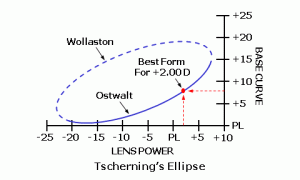As someone who has had a metric tonne load of problems in seeing clearly, I’ve become quite interested in lens design.
There’s a great course on Opticampus that explains the rationale behind and mathematics of spectacles lens design. Lens design is a trade-off between the minimisation of different forms of aberrations brought about by practical considerations such as the shape of the lens, the quality of the material and the prescription that must be glazed.
Lens designers measure differences in refraction across tangential and sagittal meridians (orthogonal meridians describing refraction of light at different degrees from the optical centre of the lens). They must minimise the oblique astigmatism which is the difference in refractive power between the 2. A good way to describe this is that light may be bent more vertically than horizontal leading to a squatter image or vice versa.
They must also compensate for power error which arises from the focal point of a perfect lens as light hits it from its range of lateral and vertical points of incidence (theoretical and ignoring oblique astigmatism) being different from the Focal Point Sphere which represents the back surface of the eye. The FPS is generally more curved and hence the lens may focus behind the eye away from the optical centre.
The best tradeoff between the refractive aberrations is called the “best form” lens. 2 different mathematicians , a century apart, showed the best form lens for various convex and concave lens designs. The best form gives you the base power of the lens, or how curved it is. See the image below.
The lower arc of the ellipse is widely used and represents a huge innovation in lens design at the start of the 20th century. The top part of Tscherning’s ellipse represents Wollaston’s original solutions to the “best form” problem. These are practically unsuitable for lots of lenses as they require a very large base curve of the lens. Consider that most sunglasses in wrap frames are base 8 or base 9 and you can see how impractical a base 20 lens would be for a relatively modest myopic (short sighted) prescription.
Lens blanks are made up in a series of base curves with acceptable ranges of aberration for their intended prescription. Major cosmetic improvements were yielded by using aspheric lens designs which sacrifice some aberration in peripheral vision versus a “perfect” lens in return for a much smaller form factor and better cosmetic appearance. They may also better balance the power error which results from a more curved FPS. Hence, aspheric lens designs give genuinely better vision and represent the next major leap in lens design following Tscherning’s ellipse.
I’ve been wondering if anyone actually uses Wollastons’ own calculations for really high power wrap lenses? Rx’s greater than -10 dioptres for instance? I presume they all just default to aspherical lens design because it’s adaptable. It’s also possible that the polynomial equations used to describe the elliptical refraction pattern of the lens yields the Wollaston best form at high powers, spherical rather than elliptical. It’s also likely that the optimal lens design is atoric, whereby the asphericity varies between meridians to correct refractive aberrations near continuously across the surface of the lens. This premium lens technology has now become quite common and is used in a wide range of lenses.
My own lenses are Zeiss Individual Single Vision (SV) which are atoric and optimised for the fit of my spectacle frames. It’s a good product and I recommend anyone wondering about it to give it a try. I’m most interested in learning other people’s experiences with wavefront lens technology as this measures how lightwaves focus in a patients eyes in an objective way, independent of the eye test. In theory, the combination of a custom atoric lens, reproduced using digital CNC technology with the design customised based on wavefront will dramatically improve the optical quality of a pair of glasses. I’ve never gotten to sample a pair myself but I’m curious to get feedback from anyone who has.
